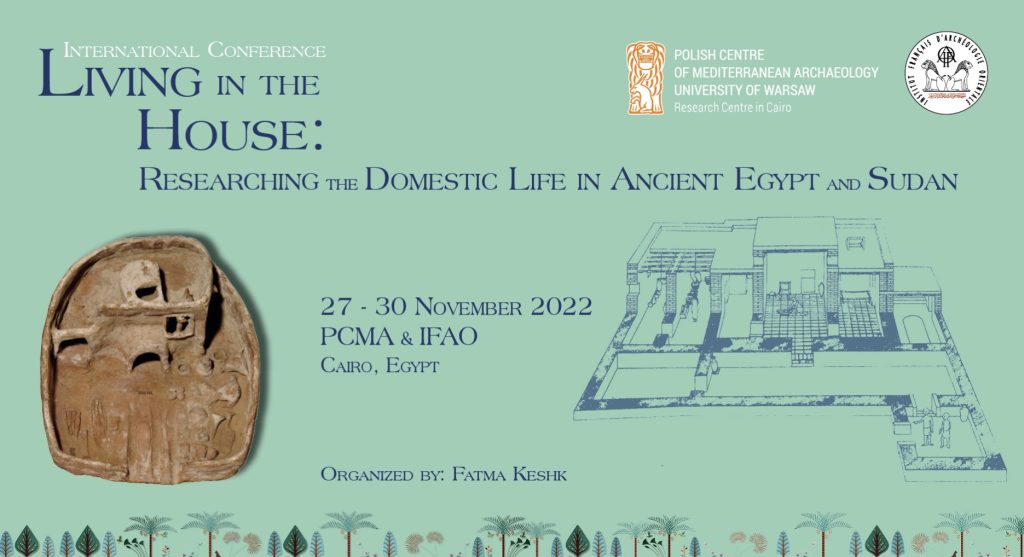Julia and I have just returned to (a very cold!) Germany, after a fantastic time in Cairo for the Living in the House: Researching the Domestic Life in Ancient Egypt and Sudan conference. The conference, organised by Fatma Keshk, was fascinating and stimulating, and it was also a great opportunity to catch up with many colleagues and friends.

The conference organised by the Institut français d’archéologie orientale (IFAO) and the Polish Centre of Mediterranean Archaeology in Cairo (PCMA), was held over four days between the two institutes and included a wide range of papers and international scholars. Despite, the significant amount of work and research that tackles settlement and domestic archaeology in Egypt and Sudan, it is rare to have an entire conference dedicated to the topic, and it was fantastic to have this conference held in Cairo. The papers covered a broad range of themes, topics, periods, and interdisciplinary approaches and has given us a lot to think about, particularly for Work Package 1 of the DiverseNile project.
The papers were very well organised into different themes, which allowed for discussion of particular topics and ideas in the time after each session. They included domestic material culture, settlement space and accessibility, the use of domestic spaces, cooking spaces and material culture, recent research on settlement excavations, architecture and building techniques, ethnoarchaeology, religion, and house property. Papers also drew on sensorial experiences and phenomenology to consider what it would have been like to actually live in these houses and settlements, focusing on the lived experience.
Therefore, papers ranged from considering broad concepts such as what makes a home and sensorial experiences of domestic architecture, to more specific practices such as cooking or particular rooms and their identification. Such as Delphine Driaux’s discussion of the bathroom in ancient Egypt, which drew on both historical and archaeological evidence. The use of different methods, sources, and interdisciplinary approaches was something which came up in all of the papers. This included Julia’s paper, which drew on examples from both the AcrossBorders and DiverseNile project to consider cooking practices in New Kingdom Egypt and Nubia, using a range of methods from ceramic analysis, organic residue analysis, to experimental archaeology. You can read more about this in some of the previous blog posts (https://www.sudansurvey.gwi.uni-muenchen.de/index.php/2022/11/24/conference-hopping-from-germany-to-egypt/, https://www.sudansurvey.gwi.uni-muenchen.de/index.php/2022/07/05/advances-in-experimental-archaeology-firing-pottery-use-of-dung-and-much-more/).
All of the papers have given us a lot to think about and consider in our own project, particularly in terms of the separation of domestic and work spaces which was brought up in a number of talks. Including in Mark Lehner’s excellent keynote on the second day, which raised an interesting discussion on the separation, or lack thereof, of public and private life. This drew on interdisciplinary approaches to the study of space and the layout of buildings from architectural and social studies.
The use or influence of interdisciplinary approaches to the study of domestic archaeology was a major theme throughout the conference, which is always fantastic to see in archaeological research. And again, gives us a lot to consider and think about! Such as the numerous ethnographic examples raised, both to provide comparisons and parallels to archaeological evidence, as well as to help us challenge assumptions and think about archaeological remains in different ways. This included Fatma Keshk’s paper on Egyptian houses, drawing on ethnography and ethnoarchaeology to give a better understanding of a number of aspects, including design, categories of houses, factors effecting use (both practical and social), as well as privacy patterns in domestic settings. Also drawing on contemporary examples, was Mennat-Allah El Dorry’s talk, which focused specifically on the kitchen and how it is identified in the archaeological record, based in many cases on modern western concepts of what constitutes a kitchen, rather than the more ephemeral and mobile nature of food preparation.
Challenges to existing assumptions about domestic archaeological interpretation were also raised in a number of other papers. Specifically, for Nubia and Sudan, this included Aaron de Souza’s paper which raised the difficulty of defining ‘Nubian’ or ‘Egyptian’ sites based on architectural and material culture remains. As well, as the long-standing historical biases of Egyptology’s colonial legacies. All of which are of course highly relevant for the DiverseNile project. It was also fantastic to have Ulrike Nowotnick give a talk on the Meroitic town of Hamadab in Sudan, to consider what life would have been like in a densely occupied Meroitic town in the Middle Nile, as well as the spatial organisation of the houses and the walled town. Archaeology in Sudan has, like in Egypt, often focused on mortuary, religious, or monumental archaeological sites.
The question of the spatial organisation of settlements and domestic spaces was another recurring theme over the four days, often in terms of state or centrally organised spaces versus individual agency and choices. Particularly, in the case of remote sites with limited access to natural resources. This is again, something which we need to think about carefully in the DiverseNile project, with the temporary nature or seasonal use of many of the sites likely linked to industrial activities, such as gold processing.
It is of course impossible to talk here about all of the discussions, topics, and papers which took place during the conference, but all the talks were recorded and are available online through the IFAO’s YouTube page. We are both very grateful to the IFAO, the PCMA, and in particular to Fatma Keshk, for an excellent and very inspiring conference.

